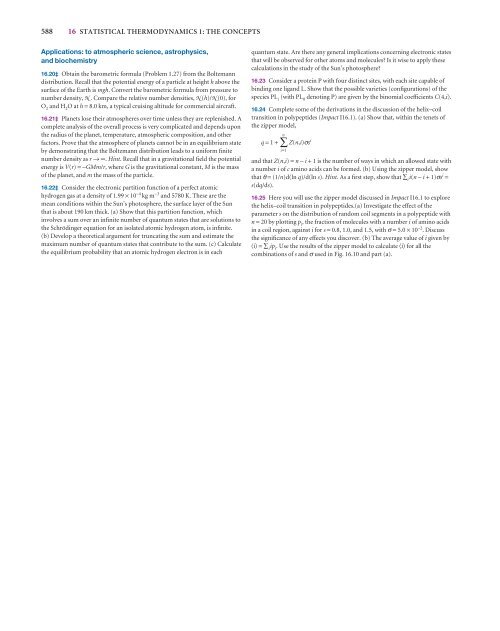Statistical thermodynamics 1: the concepts - W.H. Freeman
Statistical thermodynamics 1: the concepts - W.H. Freeman
Statistical thermodynamics 1: the concepts - W.H. Freeman
You also want an ePaper? Increase the reach of your titles
YUMPU automatically turns print PDFs into web optimized ePapers that Google loves.
PC8eC16 1/26/06 14:34 Page 588<br />
588 16 STATISTICAL THERMODYNAMICS 1: THE CONCEPTS<br />
Applications: to atmospheric science, astrophysics,<br />
and biochemistry<br />
16.20‡ Obtain <strong>the</strong> barometric formula (Problem 1.27) from <strong>the</strong> Boltzmann<br />
distribution. Recall that <strong>the</strong> potential energy of a particle at height h above <strong>the</strong><br />
surface of <strong>the</strong> Earth is mgh. Convert <strong>the</strong> barometric formula from pressure to<br />
number density, N . Compare <strong>the</strong> relative number densities, N (h)/N (0), for<br />
O 2 and H 2 O at h = 8.0 km, a typical cruising altitude for commercial aircraft.<br />
16.21‡ Planets lose <strong>the</strong>ir atmospheres over time unless <strong>the</strong>y are replenished. A<br />
complete analysis of <strong>the</strong> overall process is very complicated and depends upon<br />
<strong>the</strong> radius of <strong>the</strong> planet, temperature, atmospheric composition, and o<strong>the</strong>r<br />
factors. Prove that <strong>the</strong> atmosphere of planets cannot be in an equilibrium state<br />
by demonstrating that <strong>the</strong> Boltzmann distribution leads to a uniform finite<br />
number density as r →∞. Hint. Recall that in a gravitational field <strong>the</strong> potential<br />
energy is V(r) =−GMm/r, where G is <strong>the</strong> gravitational constant, M is <strong>the</strong> mass<br />
of <strong>the</strong> planet, and m <strong>the</strong> mass of <strong>the</strong> particle.<br />
16.22‡ Consider <strong>the</strong> electronic partition function of a perfect atomic<br />
hydrogen gas at a density of 1.99 × 10 −4 kg m −3 and 5780 K. These are <strong>the</strong><br />
mean conditions within <strong>the</strong> Sun’s photosphere, <strong>the</strong> surface layer of <strong>the</strong> Sun<br />
that is about 190 km thick. (a) Show that this partition function, which<br />
involves a sum over an infinite number of quantum states that are solutions to<br />
<strong>the</strong> Schrödinger equation for an isolated atomic hydrogen atom, is infinite.<br />
(b) Develop a <strong>the</strong>oretical argument for truncating <strong>the</strong> sum and estimate <strong>the</strong><br />
maximum number of quantum states that contribute to <strong>the</strong> sum. (c) Calculate<br />
<strong>the</strong> equilibrium probability that an atomic hydrogen electron is in each<br />
quantum state. Are <strong>the</strong>re any general implications concerning electronic states<br />
that will be observed for o<strong>the</strong>r atoms and molecules Is it wise to apply <strong>the</strong>se<br />
calculations in <strong>the</strong> study of <strong>the</strong> Sun’s photosphere<br />
16.23 Consider a protein P with four distinct sites, with each site capable of<br />
binding one ligand L. Show that <strong>the</strong> possible varieties (configurations) of <strong>the</strong><br />
species PL i (with PL 0 denoting P) are given by <strong>the</strong> binomial coefficients C(4,i).<br />
16.24 Complete some of <strong>the</strong> derivations in <strong>the</strong> discussion of <strong>the</strong> helix–coil<br />
transition in polypeptides (Impact I16.1). (a) Show that, within <strong>the</strong> tenets of<br />
<strong>the</strong> zipper model,<br />
q = 1 +<br />
n<br />
∑<br />
i=1<br />
Z(n,i)σs i<br />
and that Z(n,i) = n − i + 1 is <strong>the</strong> number of ways in which an allowed state with<br />
a number i of c amino acids can be formed. (b) Using <strong>the</strong> zipper model, show<br />
that θ = (1/n)d(ln q)/d(ln s). Hint. As a first step, show that ∑ i i(n − i + 1)σs i =<br />
s(dq/ds).<br />
16.25 Here you will use <strong>the</strong> zipper model discussed in Impact I16.1 to explore<br />
<strong>the</strong> helix–coil transition in polypeptides.(a) Investigate <strong>the</strong> effect of <strong>the</strong><br />
parameter s on <strong>the</strong> distribution of random coil segments in a polypeptide with<br />
n = 20 by plotting p i , <strong>the</strong> fraction of molecules with a number i of amino acids<br />
in a coil region, against i for s = 0.8, 1.0, and 1.5, with σ = 5.0 × 10 −2 . Discuss<br />
<strong>the</strong> significance of any effects you discover. (b) The average value of i given by<br />
i =∑ i ip i . Use <strong>the</strong> results of <strong>the</strong> zipper model to calculate i for all <strong>the</strong><br />
combinations of s and σ used in Fig. 16.10 and part (a).

















